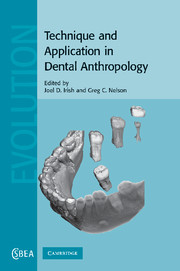Book contents
- Frontmatter
- Contents
- Contributors
- Acknowledgments
- Section I Context
- Section II Applications in assessing population health
- Section III Applied life and population history
- Section IV Forefront of technique
- 15 Methods of ingestion and incisal designs
- 16 Dental reduction in Late Pleistocene and Early Holocene hominids: alternative approaches to assessing tooth size
- 17 Dental microwear analysis: historical perspectives and new approaches
- 18 Virtual dentitions: touching the hidden evidence
- Index
- References
17 - Dental microwear analysis: historical perspectives and new approaches
Published online by Cambridge University Press: 12 September 2009
- Frontmatter
- Contents
- Contributors
- Acknowledgments
- Section I Context
- Section II Applications in assessing population health
- Section III Applied life and population history
- Section IV Forefront of technique
- 15 Methods of ingestion and incisal designs
- 16 Dental reduction in Late Pleistocene and Early Holocene hominids: alternative approaches to assessing tooth size
- 17 Dental microwear analysis: historical perspectives and new approaches
- 18 Virtual dentitions: touching the hidden evidence
- Index
- References
Summary
Introduction
Diet is widely recognized as the single most important parameter underlying behavioral and ecological differences among living animals. Bioarchaeologists and paleontologists reconstruct diets of past peoples and extinct animals for what they can teach us about matters ranging from the health status of individuals to adaptations and evolution of species. Dental microwear analysis is among the most effective ways of inferring diets of past peoples and fossil species. This approach involves the study of microscopic patterns of use-wear on teeth and is applicable to a broad range of species, giving a direct record of what an individual ate during its lifetime.
Researchers have recognized for decades that foods with given material properties leave characteristic patterns of scratches and pits in the molar teeth of humans and other animals. Foods requiring distinct types or levels of ingestive behavior also leave characteristic microscopic wear patterns in incisor teeth. Our understandings of relationships between dental microwear and diet/subsistence is improving with each passing year as new methods of analysis are developed and investigators continue to expand the number and variety of samples examined.
In this chapter we summarize one new method, dental microwear texture analysis, and offer some new data to illustrate the potential of this approach. We also briefly review some of the seminal microwear studies conducted over the past half century that put this and other work into historical context.
- Type
- Chapter
- Information
- Technique and Application in Dental Anthropology , pp. 389 - 425Publisher: Cambridge University PressPrint publication year: 2008
References
- 29
- Cited by



